
Concept explainers
Determine the kinetic energy of the 100-kg object.
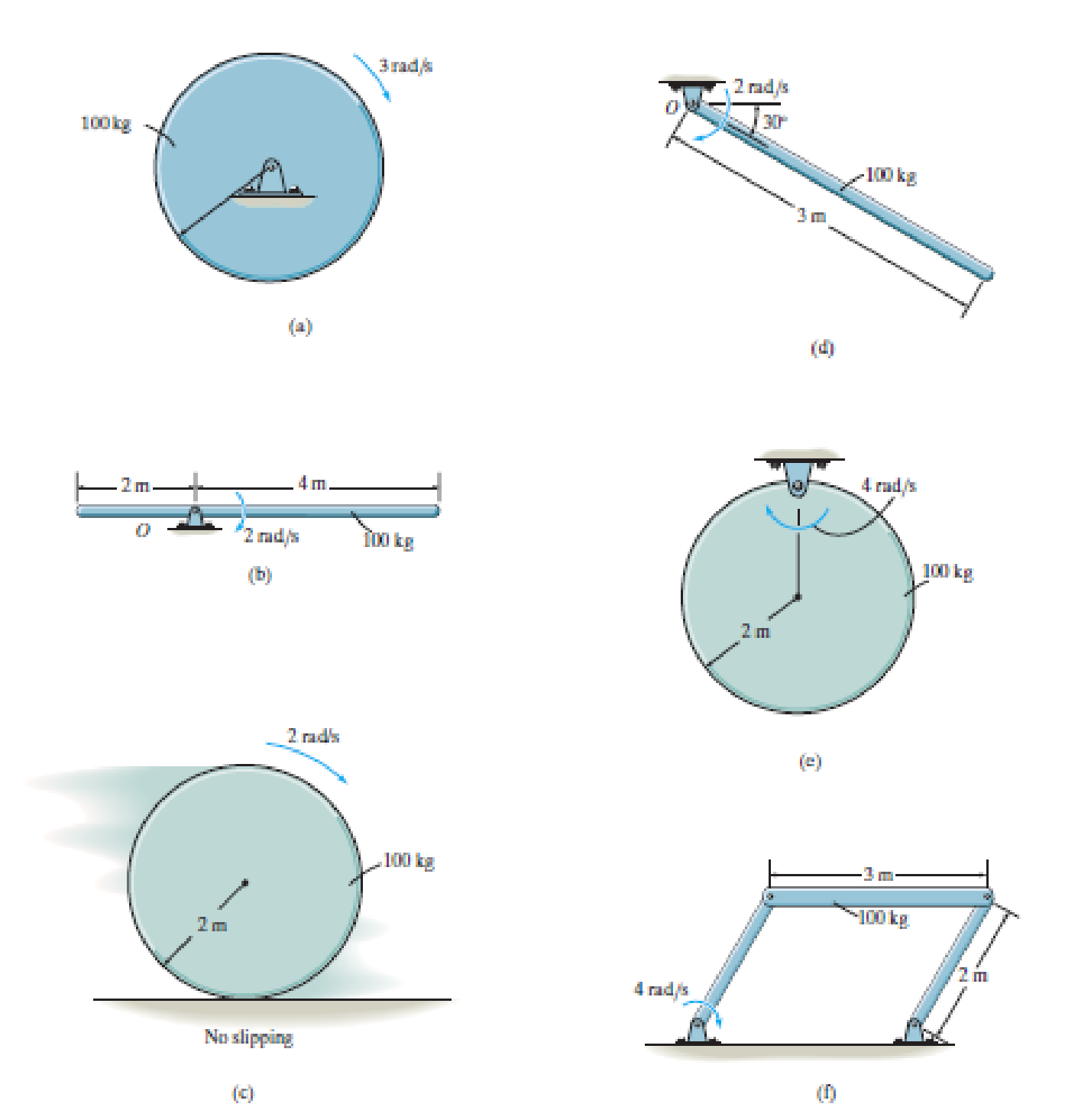
a)
The kinetic energy of the object:
Answer to Problem 1PP
The kinetic energy of the disk is
Explanation of Solution
Given:
The mass of disk is
The angular velocity of the disk is
The radius of the disk is
Draw the free body diagram of the rod as shown in Figure (1a).
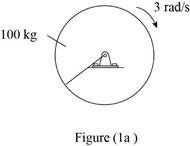
Refer Figure (1a).
Write the formula for mass moment of inertia
Here,
Write the formula for kinetic energy
(Rotation about fixed axis).
Substitute
Here,
Conclusion:
Calculate the kinetic energy of the disk.
Substitute
Thus, the kinetic energy of the disk is
b)
The kinetic energy of the object:
Answer to Problem 1PP
The kinetic energy of the disk is
Explanation of Solution
Given:
The mass of rod is
The angular velocity of the rod is
The length of the rod is
Draw the free body diagram of the rod as shown in Figure (1b).

Refer Figure (1b).
Write the formula for mass moment of inertia
Here,
Substitute
Here,
Write the formula for kinetic energy
Substitute
Here,
Conclusion:
Refer Figure (1b).
Calculate the kinetic energy of the rod.
Substitute
Thus, the kinetic energy of the rod is
c)
The kinetic energy of the object:
Answer to Problem 1PP
The kinetic energy of the disk is
Explanation of Solution
Given:
The mass of disk is
The angular velocity of the disk is
The radius of the disk is
Draw the free body diagram of the disk as shown in Figure (1c).
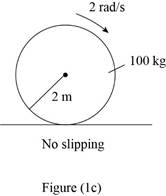
Refer Figure (1c).
Write the formula for mass moment of inertia
Here,
Write the formula for kinetic energy
Here,
Substitute
Here,
Conclusion:
Refer Figure (1c).
Calculate the kinetic energy of the disk.
Substitute
Thus, the kinetic energy of the disk is
d)
The kinetic energy of the object:
Answer to Problem 1PP
The kinetic energy of the rod is
Explanation of Solution
Given:
The mass of rod is
The angular velocity of the rod is
The length of the rod is
Draw the free body diagram of the rod as shown in Figure (1d).
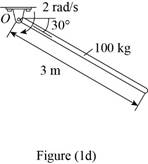
Refer Figure (1d).
Write the formula for mass moment of inertia
Here,
Write the formula for kinetic energy
(Rotation about fixed axis).
Substitute
Here,
Conclusion:
Refer Figure (1d).
Calculate the kinetic energy of the rod.
Substitute
Thus, the kinetic energy of the rod is
e)
The kinetic energy of the object:
Answer to Problem 1PP
The kinetic energy of the disk is
Explanation of Solution
Given:
The mass of disk is
The angular velocity of the disk is
The radius of the disk is
Draw the free body diagram of the disk as shown in Figure (1e).
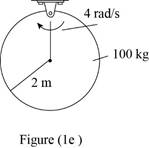
Refer Figure (1e).
Write the formula for mass moment of inertia
Here,
Write the formula for kinetic energy
Here,
Substitute
Here,
Conclusion:
Refer Figure (1e).
Calculate the kinetic energy of the disk.
Substitute
Thus, the kinetic energy of the disk is
f)
The kinetic energy of the object:
Answer to Problem 1PP
The kinetic energy of the disk is
Explanation of Solution
Given:
The mass of rod is
The angular velocity is
Draw the free body diagram of the object as shown in Figure (1f).
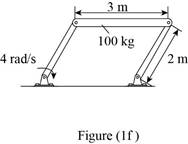
Refer Figure (1f).
Here, the ends of the rod are connected to two rods of same length. Hence the rod travels in circular motion.
Consider as the mass travels in a radius of
Write the formula for kinetic energy
(Rotation about fixed axis).
Here,
Substitute
Here,
Conclusion:
Refer Figure (1f).
Here
Calculate the kinetic energy of the disk.
Substitute
Thus, the kinetic energy of the disk is
Want to see more full solutions like this?
Chapter 18 Solutions
Engineering Mechanics: Dynamics, Study Pack, Si Edition
- Q1/ For what value of x do the power series converge: 8 (-1)n-1. x2n-1 2n-1 x3 x5 = X n=1 3 Q2/ Find the Interval of convergence and Radius of convergence of the series: 8 n Σ 3+1 n=1 (x)"arrow_forwardExample-1: l D A uniform rotor of length 0.6 m and diameter 0.4 m is made of steel (density 7810 kg/m³) is supported by identical short bearings of stiffness 1 MN/m in the horizontal and vertical directions. If the distance between the bearings is 0.7 m, determine the natural frequencies and plot whirl speed map. Solution: Barrow_forwardfind the laplace transform for the flowing function 2(1-e) Ans. F(s)=- S 12) k 0 Ans. F(s)= k s(1+e) 0 a 2a 3a 4a 13) 2+ Ans. F(s)= 1 s(1+e") 3 14) f(t)=1, 0arrow_forwardFind the solution of the following Differential Equations Using Laplace Transforms 1) 4y+2y=0. y(0)=2. y'(0)=0. 2) y+w²y=0, (0)=A, y'(0)=B. 3) +2y-8y 0. y(0)=1. y'(0)-8. 4)-2-3y=0, y(0)=1. y'(0)=7. 5) y-ky'=0, y(0)=2, y'(0)=k. 6) y+ky'-2k²y=0, y(0)=2, y'(0) = 2k. 7) '+4y=0, y(0)=2.8 8) y+y=17 sin(21), y(0)=-1. 9) y-y-6y=0, y(0)=6, y'(0)=13. 10) y=0. y(0)=4, y' (0)=0. 11) -4y+4y-0, y(0)=2.1. y'(0)=3.9 12) y+2y'+2y=0, y(0)=1, y'(0)=-3. 13) +7y+12y=21e". y(0)=3.5. y'(0)=-10. 14) "+9y=10e". y(0)=0, y'(0)=0. 15) +3y+2.25y=91' +64. y(0)=1. y'(0) = 31.5 16) -6y+5y-29 cos(2t). y(0)=3.2, y'(0)=6.2 17) y+2y+2y=0, y(0)=0. y'(0)=1. 18) y+2y+17y=0, y(0)=0. y'(0)=12. 19) y"-4y+5y=0, y(0)=1, y'(0)=2. 20) 9y-6y+y=0, (0)-3, y'(0)=1. 21) -2y+10y=0, y(0)=3, y'(0)=3. 22) 4y-4y+37y=0, y(0)=3. y'(0)=1.5 23) 4y-8y+5y=0, y(0)=0, y'(0)=1. 24) ++1.25y-0, y(0)=1, y'(0)=-0.5 25) y 2 cos(r). y(0)=2. y'(0) = 0. 26) -4y+3y-0, y(0)=3, y(0) 7. 27) y+2y+y=e y(0)=0. y'(0)=0. 28) y+2y-3y=10sinh(27), y(0)=0. y'(0)=4. 29)…arrow_forwardAuto Controls A union feedback control system has the following open loop transfer function where k>0 is a variable proportional gain i. for K = 1 , derive the exact magnitude and phase expressions of G(jw). ii) for K = 1 , identify the gaincross-over frequency (Wgc) [where IG(jo))| 1] and phase cross-overfrequency [where <G(jw) = - 180]. You can use MATLAB command "margin" to obtain there quantities. iii) Calculate gain margin (in dB) and phase margin (in degrees) ·State whether the closed-loop is stable for K = 1 and briefly justify your answer based on the margin . (Gain marginPhase margin) iv. what happens to the gain margin and Phase margin when you increase the value of K?you You can use for loop in MATLAB to check that.Helpful matlab commands : if, bode, margin, rlocus NO COPIED SOLUTIONSarrow_forwardThe 120 kg wheel has a radius of gyration of 0.7 m. A force P with a magnitude of 50 N is applied at the edge of the wheel as seen in the diagram. The coefficient of static friction is 0.3, and the coefficient of kinetic friction is 0.25. Find the acceleration and angular acceleration of the wheel.arrow_forwardAuto Controls Using MATLAB , find the magnitude and phase plot of the compensators NO COPIED SOLUTIONSarrow_forward4-81 The corner shown in Figure P4-81 is initially uniform at 300°C and then suddenly exposed to a convection environment at 50°C with h 60 W/m². °C. Assume the = 2 solid has the properties of fireclay brick. Examine nodes 1, 2, 3, 4, and 5 and deter- mine the maximum time increment which may be used for a transient numerical calculation. Figure P4-81 1 2 3 4 1 cm 5 6 1 cm 2 cm h, T + 2 cmarrow_forwardAuto Controls A union feedback control system has the following open loop transfer function where k>0 is a variable proportional gain i. for K = 1 , derive the exact magnitude and phase expressions of G(jw). ii) for K = 1 , identify the gaincross-over frequency (Wgc) [where IG(jo))| 1] and phase cross-overfrequency [where <G(jw) = - 180]. You can use MATLAB command "margin" to obtain there quantities. iii) Calculate gain margin (in dB) and phase margin (in degrees) ·State whether the closed-loop is stable for K = 1 and briefly justify your answer based on the margin . (Gain marginPhase margin) iv. what happens to the gain margin and Phase margin when you increase the value of K?you You can use for loop in MATLAB to check that.Helpful matlab commands : if, bode, margin, rlocus NO COPIED SOLUTIONSarrow_forwardAuto Controls Hand sketch the root Focus of the following transfer function How many asymptotes are there ?what are the angles of the asymptotes?Does the system remain stable for all values of K NO COPIED SOLUTIONSarrow_forward-400" 150" in Datum 80" 90" -280"arrow_forwardUsing hand drawing both of themarrow_forwardarrow_back_iosSEE MORE QUESTIONSarrow_forward_ios
 Elements Of ElectromagneticsMechanical EngineeringISBN:9780190698614Author:Sadiku, Matthew N. O.Publisher:Oxford University Press
Elements Of ElectromagneticsMechanical EngineeringISBN:9780190698614Author:Sadiku, Matthew N. O.Publisher:Oxford University Press Mechanics of Materials (10th Edition)Mechanical EngineeringISBN:9780134319650Author:Russell C. HibbelerPublisher:PEARSON
Mechanics of Materials (10th Edition)Mechanical EngineeringISBN:9780134319650Author:Russell C. HibbelerPublisher:PEARSON Thermodynamics: An Engineering ApproachMechanical EngineeringISBN:9781259822674Author:Yunus A. Cengel Dr., Michael A. BolesPublisher:McGraw-Hill Education
Thermodynamics: An Engineering ApproachMechanical EngineeringISBN:9781259822674Author:Yunus A. Cengel Dr., Michael A. BolesPublisher:McGraw-Hill Education Control Systems EngineeringMechanical EngineeringISBN:9781118170519Author:Norman S. NisePublisher:WILEY
Control Systems EngineeringMechanical EngineeringISBN:9781118170519Author:Norman S. NisePublisher:WILEY Mechanics of Materials (MindTap Course List)Mechanical EngineeringISBN:9781337093347Author:Barry J. Goodno, James M. GerePublisher:Cengage Learning
Mechanics of Materials (MindTap Course List)Mechanical EngineeringISBN:9781337093347Author:Barry J. Goodno, James M. GerePublisher:Cengage Learning Engineering Mechanics: StaticsMechanical EngineeringISBN:9781118807330Author:James L. Meriam, L. G. Kraige, J. N. BoltonPublisher:WILEY
Engineering Mechanics: StaticsMechanical EngineeringISBN:9781118807330Author:James L. Meriam, L. G. Kraige, J. N. BoltonPublisher:WILEY





